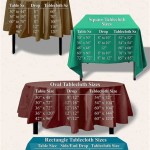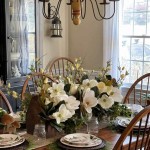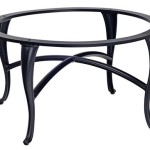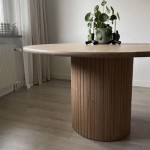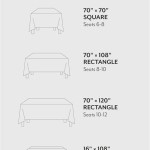What Size Square Tablecloth For 60 Inch Round Table
Selecting the appropriate tablecloth size is crucial for achieving the desired aesthetic and functional coverage on a table. When pairing a square tablecloth with a round table, particularly a 60-inch round table, careful consideration must be given to the overhang. Overhang refers to the portion of the tablecloth that drapes down from the edge of the table, contributing significantly to the overall appearance and protecting the table from spills.
The decision regarding the ideal square tablecloth size hinges on the desired overhang length. A shorter overhang creates a more contemporary, minimalist look, while a longer overhang lends a more formal and traditional feel. Furthermore, the intended use of the table should influence the choice. For instance, a table used primarily for dining might benefit from a longer overhang to protect guests' laps from accidental spills. Conversely, a purely decorative table might only require a minimal overhang.
This article provides a comprehensive guide to determining the appropriate square tablecloth size for a 60-inch round table, taking into account various overhang lengths and aesthetic considerations. It will explore the mathematical calculations involved, offer practical advice, and discuss the impact of fabric choice on the final appearance.
Calculating the Appropriate Tablecloth Size
The fundamental principle in determining the correct square tablecloth size for a 60-inch round table involves adding the desired overhang to the table's diameter. The table's diameter, in this case, is 60 inches. The overhang is the distance the tablecloth extends beyond the edge of the table. As the tablecloth is square, the same overhang is applied to all sides. Therefore, the calculation can be represented as follows:
Tablecloth Size = Table Diameter + (2 x Overhang)
This formula provides the minimum size the square tablecloth needs to be to achieve the desired overhang. For example, to achieve a 12-inch overhang, the calculation would be:
Tablecloth Size = 60 inches + (2 x 12 inches) = 60 inches + 24 inches = 84 inches
Therefore, an 84-inch square tablecloth would provide a 12-inch overhang on a 60-inch round table. It is essential to consider the purpose of the table and the desired aesthetic when selecting the overhang length. Different overhang lengths produce very different effects.
Small overhangs, typically ranging from 6 to 8 inches, offer a casual and modern look. They are suitable for everyday use and smaller spaces. Medium overhangs, between 10 and 12 inches, strike a balance between formality and practicality, making them a versatile choice for various occasions. Longer overhangs, exceeding 15 inches, are generally reserved for formal events and special occasions, creating a sense of elegance and sophistication. A "puddle" overhang, where the tablecloth touches the floor, is the most formal and requires very precise measurements to avoid the fabric appearing bunched or uneven.
Therefore, selecting the desired overhang is the first key step in determining the correct tablecloth size. Once the overhang length is known, the appropriate square tablecloth size can be calculated using the above formula.
Impact of Overhang Length on Aesthetics and Functionality
The length of the tablecloth overhang significantly affects the visual appeal of the table setting. A shorter overhang creates a cleaner, more contemporary aesthetic, highlighting the table itself. This is particularly suitable for tables with attractive bases or legs that you wish to showcase. Shorter overhangs also tend to be more practical for everyday use, requiring less fabric and minimizing the risk of tripping or snagging.
Conversely, a longer overhang creates a more formal and dramatic effect. It conceals the table legs and draws attention to the tablecloth itself. This is often preferred for formal dining rooms or special occasions where a sense of elegance is desired. However, longer overhangs require more fabric, which can increase the cost of the tablecloth. They also present a greater risk of accidental spills and require more careful handling to prevent damage.
Functionally, the overhang serves to protect the table surface from spills and scratches. A longer overhang provides greater coverage, minimizing the risk of liquids dripping onto guests' laps or the floor. It also helps to create a more intimate and enclosed dining experience. However, an excessively long overhang can be cumbersome and impede movement around the table. It can also create a trip hazard, especially for children or elderly guests.
The overhang should be chosen carefully taking into account the frequency of use, the audience using the table, and the overall style that needs to be conveyed. A balance between the aesthetic desired and the practicality requires consideration before deciding on the ideal overhang length.
Fabric Considerations and Adjustments
The choice of fabric also influences the final appearance and perceived size of the tablecloth. Heavier fabrics, such as linen or damask, tend to drape more gracefully and create a more substantial overhang. Lighter fabrics, such as cotton or polyester, may require a slightly longer overhang to achieve a similar effect. Furthermore, some fabrics are prone to shrinkage after washing, which should be factored into the initial measurement.
Before making a final decision, it is recommended to wash and dry the tablecloth according to the manufacturer's instructions. This will allow for any shrinkage to occur before the tablecloth is used. If shrinkage is anticipated, an additional allowance should be added to the calculated tablecloth size.
Additionally, the weave and texture of the fabric can affect how the tablecloth hangs. A tightly woven fabric will hold its shape more readily, while a loosely woven fabric may drape more fluidly. The pattern on the fabric can also influence the perceived size of the tablecloth. A large, bold pattern may make the tablecloth appear larger, while a small, subtle pattern may have the opposite effect. When choosing fabric, consider how different textures may affect the fall of the tablecloth.
Seam allowances are also important. If sewing a tablecloth, allow enough extra fabric for the hem. Also, if the fabric has a prominent pattern, ensure there is enough fabric to appropriately center it so the design is balanced when the tablecloth is on the table. The extra fabric added for the seam allowance must also be accounted for when determining the overall square tablecloth size.
Ultimately, the choice of fabric is a matter of personal preference. However, it is essential to consider the properties of the fabric and how they will affect the overall appearance and functionality of the tablecloth. Careful consideration of fabric properties and potential shrinkage ensures the final result meets expectations.

Square Tablecloth Sizes On 60 Inch Round Table And Other Linen Cloth

Round Tablecloth Size Guide Textile Town Sizes Table Cloth

Tablecloth Size Guide For Square Rectangular Round Tables

Tablecloth Size Guide Round Tables Sizes Table Cloth Linen Settings

Round Tablecloth Size Guide Textile Town

Linen Als What Size Of Tablecloth Do I Need Beyond Elegance Party

Let S Talk Linens The Ultimate Guide To Table Linen Sizes Party Al Ltd Pink Hippo Blog

3 Easy Ways To Measure Tablecloth Sizes Your Table Linens Size Guide

Lushvida Round Tablecloth 60 Inch Black Stain And Water Resistant Table Cover For Kitchen Dining Room Com

Round Tablecloth Size Guide Textile Town
Related Posts



